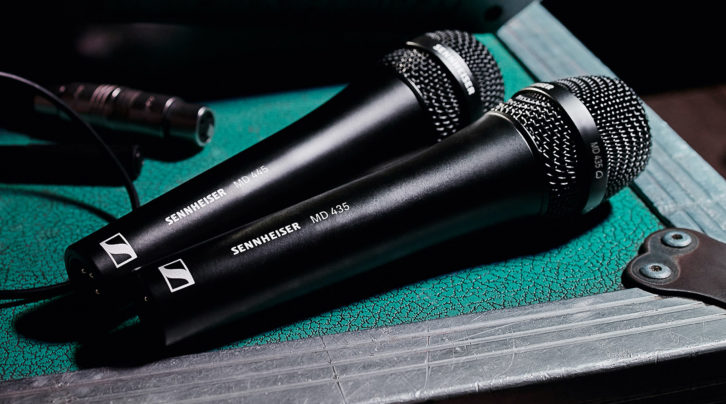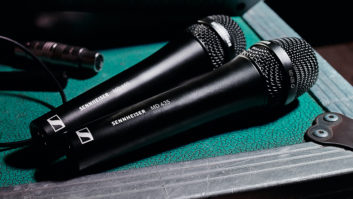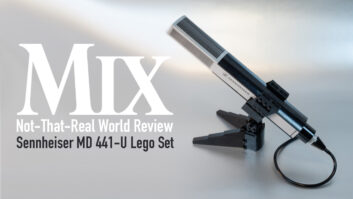
The Sennheiser MD Series is well-established as the company’s premium range of dynamic microphones, with a lineage of vocal and instrument mics dating back 75 years.
The MD 435 and MD 445, two recent additions to the line, are wired, handheld vocal microphones positioned at the top of the MD range and intended for use on stage in high-volume situations requiring uncompromised sound reproduction.
The MD 435 and MD 445 share a similar appearance and physical specs. The bodies have a classy, nice-looking, satin-black finish, and they feel solid (if a tad heavy) in the hand. The head grilles supply the only clue that the mics are different: the grille on the supercardioid MD 445 is slightly shorter and flatter than that of the cardioid MD 435. Capsules in both models are spring-mounted for isolation, employ lightweight aluminum-copper voice coils for fast transient response, and feature hum compensation coils to reduce EMI.
Each microphone is packaged in a carboard shipping box with a nylon zippered pouch, a mic stand clip and five replacement pop shields (for use underneath the metal head grille). Quick Start guides include helpful illustrations indicating optimum placement of wedge monitors relative to the mics’ respective pickup patterns.
STARTING WITH SPECS
Frequency response for the MD 435 is stated as 40 Hz to 20 kHz, with a frequency-response plot that shows a rise in the curve starting at 2 kHz, reaching a maximum of about 8 dB at 6 kHz, then falling to +5 dB at 8k before rolling off above 10 kHz. The MD 435 can handle a maximum SPL of 163 dB at 1 kHz and has an equivalent noise spec of 17 dBA, yielding a dynamic range of 146 dBA. Nominal impedance is 245 Ohms.
The capsule of the MD 435 replicates the sound of the Sennheiser MD 9235 capsule, which is popular for use in live and broadcast production but was previously available only as a head for Sennheiser handheld wireless transmitters. [The MD 435 and MD 445 capsules are available as transmitter heads that can be used with Sennheiser wireless gear, including evolution wireless G4, 2000, Digital 6000 and Digital 9000 Series.]
SSL UF8 Advanced Studio DAW Controller – A Real-World Review
Frequency response of the MD 445 is also 40 Hz to 20 kHz, exhibiting an overall tilt toward the high end of the spectrum from 50 Hz to 2 kHz. There’s a broad peak between 3 and 8 kHz, and a fairly steep rolloff above 10 kHz. Maximum SPL for the MD 445 is 163 dB, and equivalent noise is 18 dBA, giving the MD 445 a dynamic range of 145 dBA. Nomimal impedance is 245 Ohms.
I used the MD 435 and MD445 on the road over the past couple of months in a variety of situations with different vocalists. It was immediately apparent that both microphones do a great job of rejecting unwanted sound. Leakage from wedge monitors or instruments on the stage was minimal, and in cases where the stage volume was relatively low, you could barely hear any leakage through either mic.
The MD 435 and MD 445 don’t have a lot of “reach,” meaning that sounds are noticeably attenuated once the mic is moved beyond approximately one foot from the source. That includes vocals, so if your singer is accustomed to working the mic from a distance, the MD 435 and MD 445 are probably not going to be good choices.
MD 435
The MD 435 delivers a very smooth, balanced timbre that works well for female or male singers who have an emphasis in the upper-midrange of their voices. It has the ability to smooth out voices with aggressive upper-mids while still maintaining clarity. If you’re working with a singer who sometimes sounds harsh, then the MD 435 is a good choice.
When the mic is used with vocalists who don’t have a lot of high-end content to their voices, a bit of EQ can help improve presence. A high-frequency shelf starting around 3 kHz with a boost of 2 or 3 dB opened up the sound of the microphone nicely on a singer who had a dark voice. The MD 435 did not require the low-mid scoop I sometimes need to improve articulation or to help a vocal cut through a busy mix.
If a vocalist works the MD 435 within a range of about ±30 degrees on-axis, pickup is fairly forgiving and frequency response is consistent. Once the source moves 45 degrees (or more) off-axis, you can hear the bottom end begin to drop off and overall attenuation becomes significant. At 90 degrees off-axis, there isn’t much happening—clear evidence of the mic’s ability to reject off-axis sound. If your vocalist holds the mic 90 degrees off-axis from his or her mouth, then they get what they deserve(!).
Bottom-end extension of the MD 435 is very good, which works out to be a bit of a mixed blessing: On the one hand, it enables the mic to capture the chestiness of a male voice; on the other hand, it means that the mic sometimes produces pops.
A highpass filter set between 100 and 130 Hz (depending on the singer) helped reduce popping. Proximity effect becomes apparent and generally flattering on the MD 435 within a distance of around 3 to 4 inches, but it does not become overbearing when the singer has their mouth directly on the grille.
MD 445
Differences between the MD 435 and MD 445 are not simply a case of differing polar patterns; they are sonically very different animals. The MD 445 is a more aggressive sounding mic that can help a vocal cut through the busiest of mixes, even if that vocal doesn’t have a lot of natural presence. As a result, I felt that the MD 445 worked best for singers who don’t have an inherent “pointiness” or forward midrange to their voice.
For example, the MD 445 complemented singer Don “Buck Dharma” Roeser’s voice because he tends to have a mellow timbre that often needs either a dip around 300 Hz or a boost in the region between 3 kHz and 4 kHz to help cut through. When he sang on the MD 445, I needed just a pinch of EQ (-2 dB at 340 Hz) to enhance intelligibility. Don’s voice is not sibilant, so “S” and “T” sounds were not an issue when he sang on the MD 445—but beware, as sibilant singers can become more apparently so when using the MD 445.
The MD 445 can also produce some serious low end, which can result in popping and becomes more pronounced due to proximity effect (more so than the MD 435). A highpass filter set around 100 – 120 Hz helped reduce popping for singers who like to work close.
The sound of the MD 445 seems to bloom when a vocalist works the mic within an inch or two of the grille, though it also captures more breath noise at that distance than does the MD 435.
Off-axis performance of the MD 445 is less forgiving than that of the MD 435: by the time a sound source is 30 degrees off-axis of the MD 445, attenuation is already in the range of 6 dB, and the high-frequency response begins to roll off. Beyond ±45 degrees off-axis, the MD 445 doesn’t capture much at any frequency. For those reasons I wouldn’t recommend using the MD 445 with a singer who doesn’t remain consistently on-mic.
As was the case with the MD 435, isolation of the MD 445 capsule from external noise was excellent—though I thought the MD 445 might be a hair better in this category. Both microphones did an excellent job at rejecting handling noise, as well as noise transmitted through mic stands.
Sennheiser has done a great job on the MD 435 and MD 445. Frequency response of the mics is extended and smooth, and each mic targets a different type of voice. Both models help vocals cut through a mix without being harsh, and perform well on loud stages where a vocalist works the mic up-close; the MD 435 is a little more forgiving in this category, but not by much.
Rejection of off-axis sound and background noise is very good, resulting in minimal leakage— and they look good, too! These mics are serious tools intended for use in critical, professional applications.
PRODUCT SUMMARY
COMPANY: Sennheiser
PRODUCT: MD 445 and MD 435 Dynamic Vocal Microphones
WEBSITE: https://en-us.sennheiser.com
PRICE: $619 each
PROS: Solid construction; strong rejection of unwanted sound; high intelligibility.
CONS: MD 445 can be a bit aggressive for certain singers and may be susceptible to pops; might be bit on the pricey side for some users







